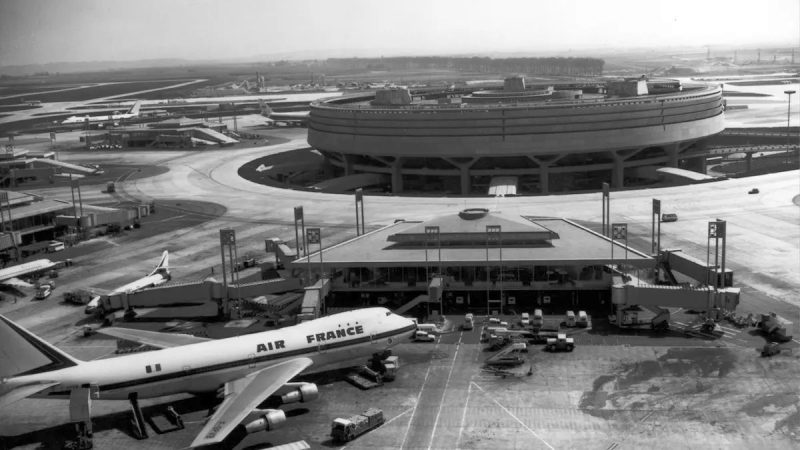Just over 50 years ago, on March 13, 1974, the then new Paris-Charles de Gaulle Airport was opened. Since then, this has been Air France's international hub. Domestic flights, which at the time were served by Air Inter among others, continued to be offered primarily from Orly for the time being.
In 1996, Air France established its global hub in this city, where travelers from all over the world cross paths every day. Today the airline is responsible for more than half of the airport's traffic and connects Paris to over 200 destinations in almost 100 countries worldwide. The need for a third Paris airport became apparent as early as the 1950s, as traffic increased at the capital's historic airports, Paris-Le Bourget and Paris-Orly.
This first terminal, designed by the young architect Paul Andreu, featured an innovative design: a central circular building connected to seven satellites. This unique structure, which was intended to facilitate the distribution of passenger flows, gave the terminal its nickname “Camembert”, which is still used today.
The first Air France flight from Paris-Charles de Gaulle took off on April 30, 1974. The Caravelle F-BHRA, the first aircraft of this type delivered to Air France, took off for Belgrade and Sofia with a crew led by the flight captain Henri Cibert. The company's flights gradually shifted to Paris-Charles de Gaulle, initially serving domestic (Bordeaux, Nice, Toulouse) and European destinations (London, Geneva, Frankfurt, Turin and Lisbon).
The majority of its operations were relocated in November 1974, with two-thirds of the national airline's flights and part of its maintenance operations moving to Paris-Charles de Gaulle. The airport, then known as Paris-Roissy Charles de Gaulle, became Air France's main hub.
Two years later, in 1976, Concorde joined the Air France fleet and flew at supersonic speeds to Dakar, Rio de Janeiro, Caracas, Washington, Dallas and New York JFK. Paris was now 3,5 hours from New York and customers traveling aboard Concorde benefited from a dedicated airport experience and lounge. Inspired by growing traffic, Paris-Charles de Gaulle was redesigned and expanded several times. Air France has moved several times to offer its customers individual, increasingly comfortable infrastructures adapted to the company's growth.
With the opening of Terminal 2 in Paris-Charles de Gaulle, Air France was able to expand its route network, especially in Europe, from 1982 onwards. Thanks to its brand new fleet of medium-haul aircraft (Boeing 737, then Airbus A320), the company multiplied its routes and offered an increasingly dense network. In 1988, Air France served most destinations in Europe.
In 1996, the year Terminal 2E opened, Air France began a major restructuring. The airline reorganized its operations to make Paris-Charles de Gaulle a hub for connecting flights: seven coordinated connecting flights were organized throughout the day, combining short- and medium-haul flights with long-haul flights. Flight operations became better distributed, connections quicker and easier, and Paris-Charles de Gaulle became a true global hub. This major project allowed the airline to operate up to 60 flights per hour and welcome a growing number of passengers.
In 2000, Paris-Charles de Gaulle added a fourth runway, a first in Europe. Terminal 2E also experienced several phases of growth, with the opening of Hall L in 2007, followed a few years later by Hall M. These successive expansions allowed the terminal to increase its capacity by 20 million passengers per year. To facilitate the connection, Air France's partner airlines, particularly members of the Skyteam alliance, were stationed in the terminals operated by Air France.
Connectivity is one of the main advantages of Paris-Charles de Gaulle, the only Paris airport directly connected to the RER B and equipped with a TGV station. This rail connection will allow Air France to expand its intermodal offering with SNCF and give customers the opportunity to combine rail and air travel on a single ticket.
50 years after its opening, Paris-Charles de Gaulle now has 9 terminals. It is the largest airport in France and the second largest in Europe and the main gateway to the European Union. As the main user of the airport with 50% of traffic, Air France operates 650 departing and arriving flights daily and offers 25.000 connections per week in less than 2 hours. 100.000 Air France customers are welcomed every day, some of whom visit the company's 6 lounges (Business and Flying Blue Elite lounges in Terminals 2F, 2G, 2E Halls K, L and M, La Première lounge in Terminal 2E) .
The lounge in Terminal 2F is the latest space to be inaugurated by Air France and welcomes the company's business customers and Flying Blue Elite Plus customers on two levels. Through the curved “runway view” window designed by architect Sanjit Manku and designer Patrick Jouin, customers can admire the approximately 240 aircraft in the French airline's colors as they prepare to depart for 200 destinations worldwide.










 trail (for them it's free to use)
trail (for them it's free to use)